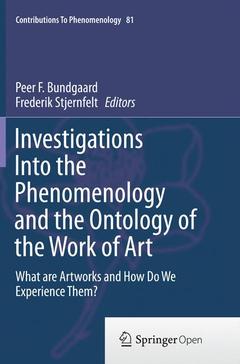Description
Investigations Into the Phenomenology and the Ontology of the Work of Art, Softcover reprint of the original 1st ed. 2015
What are Artworks and How Do We Experience Them?
Contributions to Phenomenology Series, Vol. 81
Coordinators: Bundgaard Peer F., Stjernfelt Frederik
Language: English
Subject for Investigations Into the Phenomenology and the Ontology...:
Support: Print on demand
Description
/li>Contents
/li>Biography
/li>Comment
/li>
Introduction: Peer F. Bundgaard.- Temporal aspects of literary reading; David S. Miall.- Memory and mental states in the appreciation of literature; Marisa Bortolussi and Peter Dixon.- Temporal conflict in the reading experience; Cathrine Kietz.- The aesthetic experience with visual art “at first glance”; Paul J. Locher.- What is a surface? In the real world? And pictures?; John M. Kennedy and Marta Wnuczko.- The idiosyncrasy of beauty: Aesthetic universals and the diversity of taste; Patrick Colm Hogan.- Why we are not all novelists; Shaun Gallagher.- Aesthetic relationship, cognition, and the pleasures of art; Jean-Marie Schaeffer.- More seeing-in: surface seeing, design seeing, and meaning seeing in pictures; Peer F. Bundgaard.- Depiction; John Hyman.- Green war banners in central Copenhagen: A recent political struggle over interpretation — and some implications for art interpretation as such; Frederik Stjernfelt.- The appropriation of the work of art as a semiotic act; FrancisÉdeline and Jean-Marie Klinkenberg.- Sculpture, diagram, and language in the artwork of Joseph Beuys; Wolfgang Wildgen. Index.
Peer Bundgaard is professor at the Center for Semiotics, Aarhus University, and is the Editor-in-Chief of Cognitive Semiotics.
Frederik Stjernfelt is professor at the Center for Semiotics, Aarhus University, and is member of the Danish Academy as well as the Royal Danish Academy of Sciences and Letters. Post-doctoral habilitation Diagrammatology (Springer 2007). He is also a guest professor at Humboldt University Berlin 2010.

